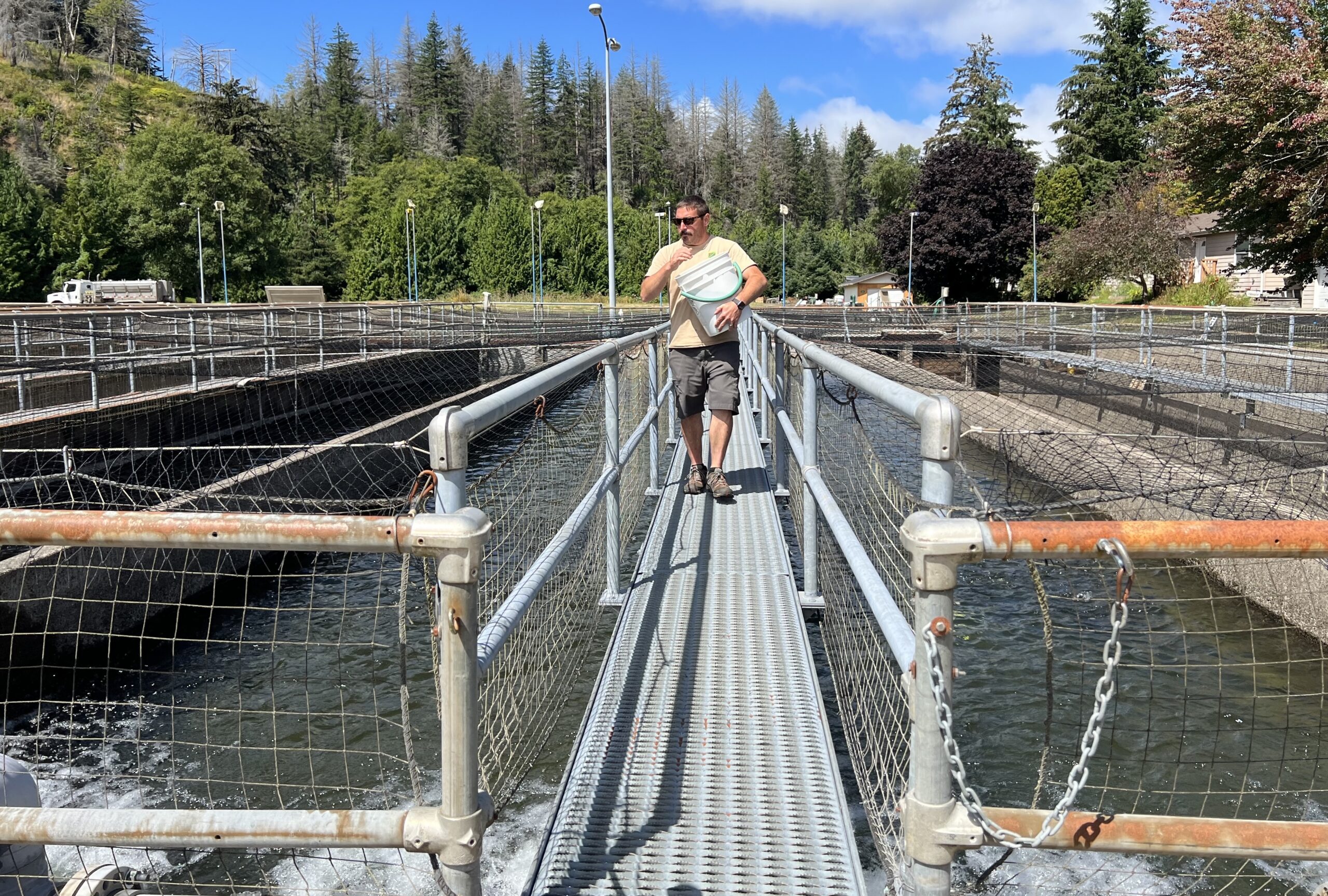
By QUINTON SMITH/YachatsNews
OTIS – Clayton Morgan has spent the last eight years caring for hundreds of thousands of salmon, steelhead and trout at the state’s hatchery along the Salmon River northeast of Lincoln City.
He and his family along with two other Oregon Department of Fish & Wildlife employees live at the hatchery, pulling shifts over seven days a week and responding to emergencies in the middle of the night.
Their jobs involve dozens of tasks ranging from putting in and taking out weirs in the Salmon River below the hatchery, monitoring the huge electric pumps that pull up river water to circulate through holding ponds, harvesting or sorting the salmon that return each fall, raising incubated eggs to fingerling and smolts and then feeding them once they are in ponds, or protecting the hatchery when catastrophes like the 2020 Echo Mountain fire swept through the Otis community.
Now Morgan expects he will be looking for a job – hopefully still with ODFW and doing what he went to college for, but possibly returning to the construction trade.

That’s because ODFW plans to shutter the 49-year-old hatchery – plus another near Roseburg and a research facility east of Waldport – due to an impending $8 million hole in its proposed 2025-27 budget. And by almost every measure the Salmon River Hatchery is the most inefficient to operate of the 14 such facilities ODFW owns across the state.
“The Salmon River Hatchery has gone through this potential closure process before,” Morgan says. “But now it’s a more public talk.”
The planned closures are part of a three-pronged effort by ODFW to deal with the $8 million budget shortfall, developing a proposed 2025-27 budget reflecting potential 10 percent cuts across much of the agency’s programs, and taking a deep, months-long look into all its hatchery operations.
The most immediate cuts have largely involved internal staff discussions and a report in June to ODFW’s seven-member commission. The cuts are made necessary due to inflation, state employee raises, and rapidly rising costs of everything from fish food to electricity to charges from other state agencies.
The proposed 10 percent cuts for 2025-27 were compiled by agency staff after talking to stakeholders and approved by the ODFW commission in June.
The hatchery resiliency study is funded by $1 million from the 2023 Legislature and, with the help of consultants, has mostly involved economic and climate studies, discussions with 10 fishing and other interest groups, and three hour-long public webinars in August.
The proposed 2025-27 budget and its associated cuts – which could be offset somewhat by the first license increase in four years, a new $9 yearly saltwater fishing endorsement, and possibly the first increase in commercial harvesting fees in nine years – will be ultimately determined during the legislative session that begins in January. But during that session the ODFW and its supporters will be fighting for money that is also needed for schools, roads, housing, drug programs, state employee salaries and benefits, and a thousand other demands.
“It is important to note that, without the commercial and recreational fee adjustments, these reductions will be even more extreme,” an ODFW memo says in laying out the planned hatchery closures and cuts to or elimination of eight other programs. “While the planned reductions will be difficult, they are necessary to offset the rapidly rising costs of doing business and reduce the scale of fee increases needed to maintain programs.”
The proposed closures of the Salmon River and Rock Creek hatcheries would save $2 million a year, according to ODFW’s estimates. Closing the Oregon Hatchery Research Center and the proposed elimination of 11 staff in fish monitoring programs would save $3.3 million.
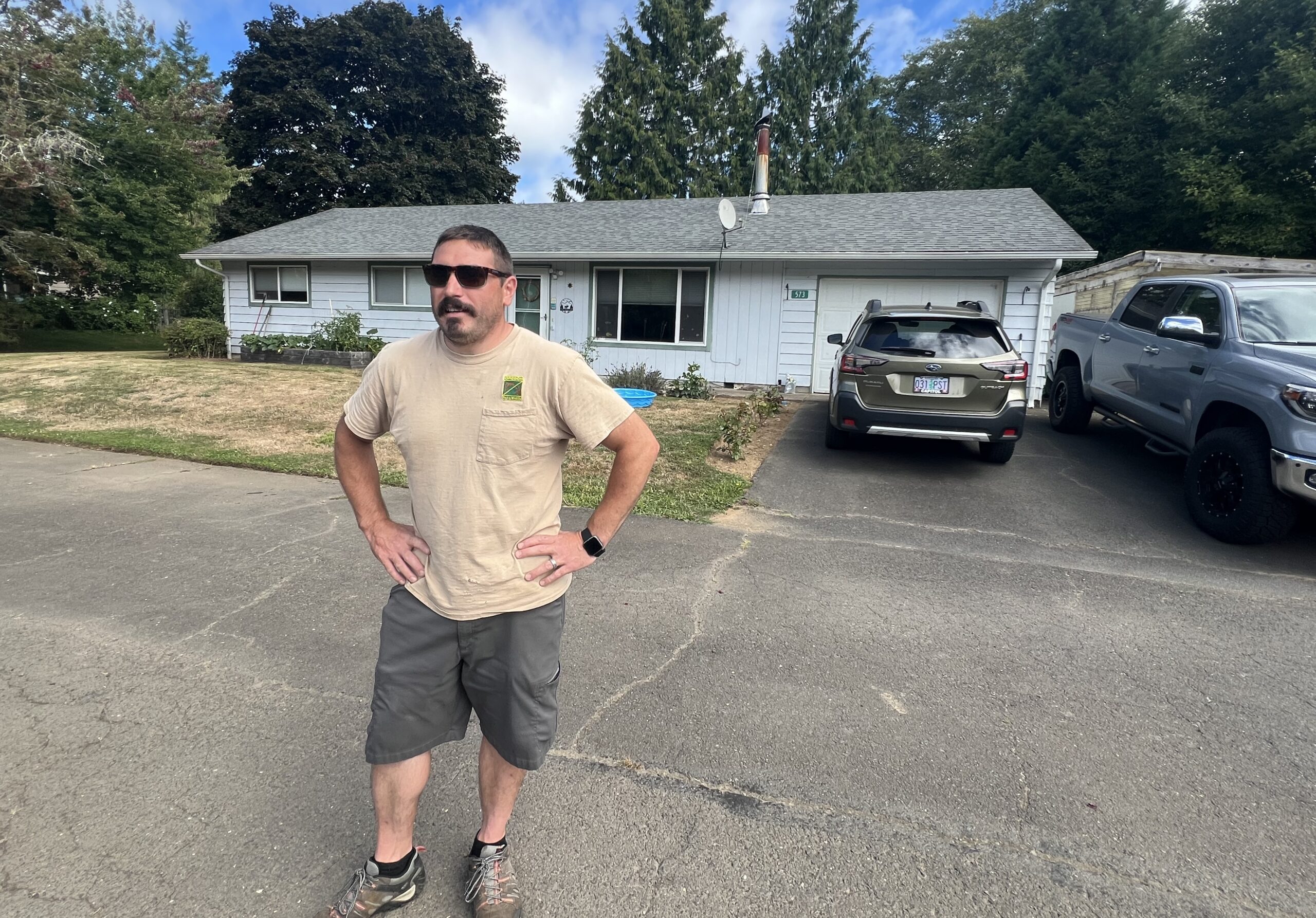
The Salmon River Hatchery
The Salmon River Hatchery sits on 23 acres seven miles northeast of Lincoln City. It contains living quarters for the three ODFW employees, offices, six holding and rearing ponds and raceways where fish live before their release, and a separate building where eggs are grown into tiny fish.
Its output includes:
- Raising and releasing 200,000 fall Chinook salmon smolts specially tagged and clipped for tracking purposes as part of the Pacific Salmon Treaty between the United States and Canada;
- Raising more than 300,000 coho salmon fingerlings to deliver to rearing pens near Astoria, where they grow to smolt size and released into the Columbia River to augment commercial and recreation fisheries;
- Raising 50,000 summer steelhead smolts for release each spring into the Siletz River; and
- Raising 40,000 trout that are released into lakes on the central and north Oregon coasts.
If the hatchery closes, some – but possibly not all – of its fish production could be moved to other hatcheries if state fish managers can find extra capacity at other facilities. But it’s not yet clear if that’s feasible.
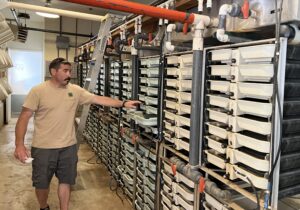
The situation is also tricky because hatchery-raised salmon will still return for years after the facility is shuttered. To prevent hatchery Chinook from going farther upriver to mix with wild fish, ODFW will still need to send staff to the hatchery each fall for five years or more to capture the returning salmon and sort out hatchery fish from wild fish.
“You just can’t close it and walk away,” said John Spangler, the ODFW’s mid-coast fish biologist based in Newport. “There’s just so many programs attached to it.”
The agency could also lose the ability to augment summer runs of steelhead in the Siletz River, which have been rebounding nicely.
One of the things that makes the Salmon River Hatchery expensive to operate is because the agency spends $5,000 a month just for electricity to run pumps that pull water from the Salmon River below the hatchery. All other ODFW hatcheries have streams that naturally feed their operations.
The hatchery – like several other ODFW facilities — is also affected by river water temperatures that have been steadily rising over the years. A water temperature of 52 to 57 degrees is best for raising fish. But water temperatures at the Otis hatchery reached the upper 60s and 70s this summer – and has spiked to 100 degrees before — leading to bacterial disease in August that forced an earlier-than-preferred release of fall Chinook smolts.
Despite its issues, the hatchery occupies a unique spot in international Chinook salmon management.
Each year the 200,000 or more fall Chinook smolts raised at the hatchery are electronically tagged and fin clipped so researchers can monitor the 3-5 years they spend off the coasts of southeast Alaska, British Columbia and Vancouver Island – and then how many are caught by commercial and sport fisheries there. Once a threshold is reached, those valuable fisheries are closed to allow enough to return to Oregon coastal streams.
“It’s a very rare gem in terms of fishery analysis and management,” says Ethan Clemons, a Newport-based analyst for ODFW’s coastal chinook research and monitoring project, which is also facing cuts. “It has an impact on how international and domestic fisheries are managed and it’s an obligation the state has as part of the Pacific Salmon Treaty.”
In an interview with YachatsNews, ODFW fish division manager Mike Harrington said the agency has been dealing with rapidly escalating costs and flat revenue and therefore needs to make cuts to many operations and to also propose fee increases.
“The Salmon River and Rock Creek hatcheries were chosen for closure because our analyses to date suggest that these two facilities are the most vulnerable to climate change (decreased flows, increased temperatures, fires, flooding) and will be among the costliest to maintain going forward because of the deferred maintenance costs …” Harrington said in an email.
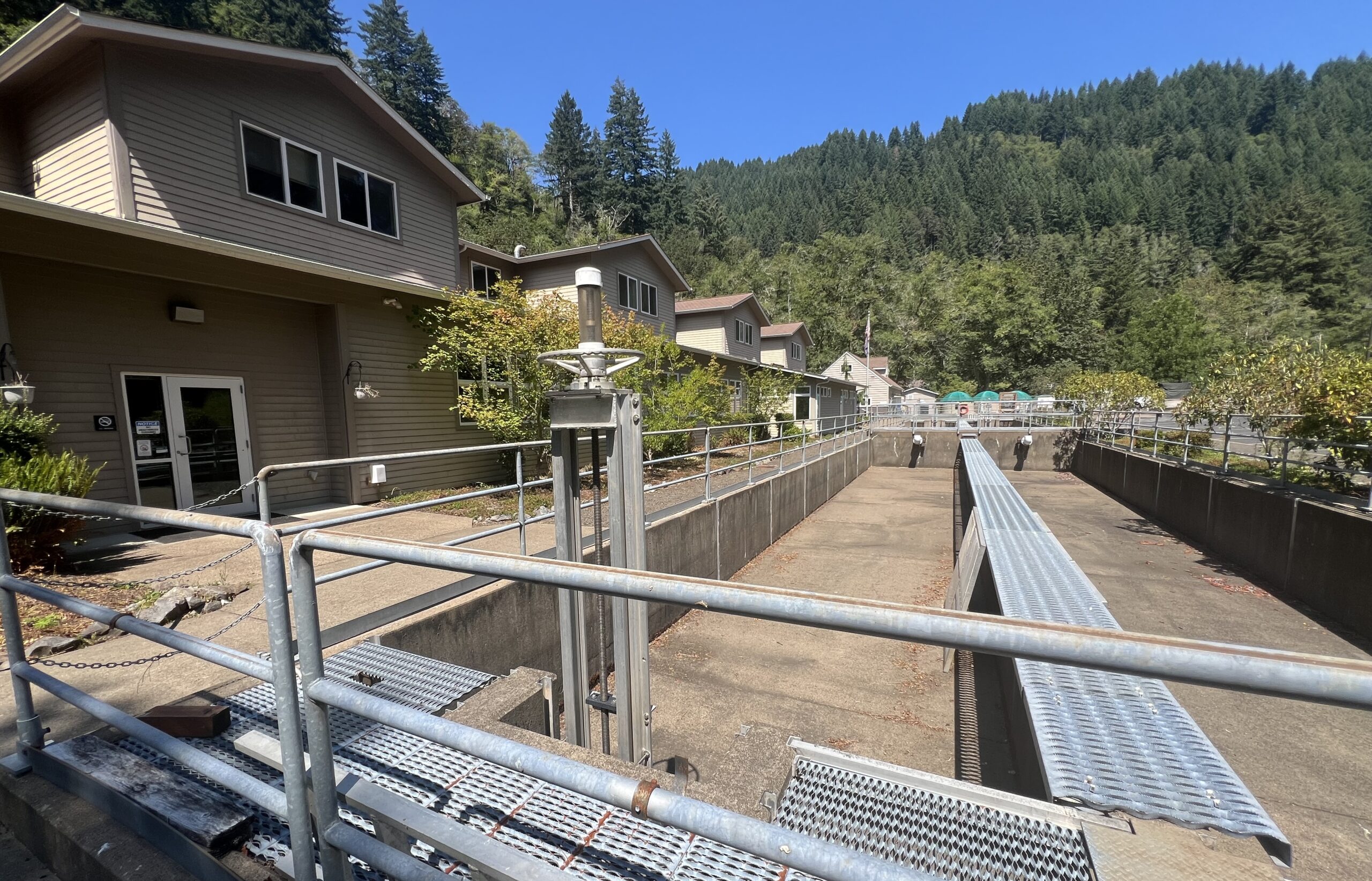
Research center closed
The Salmon River Hatchery is not the only one affected by the immediate cutbacks.
In December, ODFW closed its Oregon Hatchery Research Center that sits along Fall Creek 27 miles east of Waldport after it determined a big 2020 landslide on Weyerhaeuser property upriver continues to make it too hard to keep silt out of its raceways, ponds and research work.
The center sits on the site of a state coho salmon hatchery that closed in 1997. Eight years and $7.5 million later it reopened as a place for scientists from around the Northwest and the world to conduct research on hatchery salmon and steelhead.
Now, that research has moved to Oregon State University and other hatcheries and the facility shuttered except for a volunteer caretaker living out of a travel trailer.
The agency is unsure what it will do with the facility, which has houses for three employees, an exhibit area, laboratories, offices, and a large conference area.
The other affected facility is the Rock Creek Hatchery on the North Umpqua River, 23 miles east of Roseburg which used to produce fall and spring Chinook, coho, summer and winter steelhead, and trout. Hatchery buildings were destroyed in the 2020 Archie Creek Fire and while there is limited Chinook, steelhead and trout production, chronic low stream flows and high water temperatures led to an ODFW decision not to rebuild it.
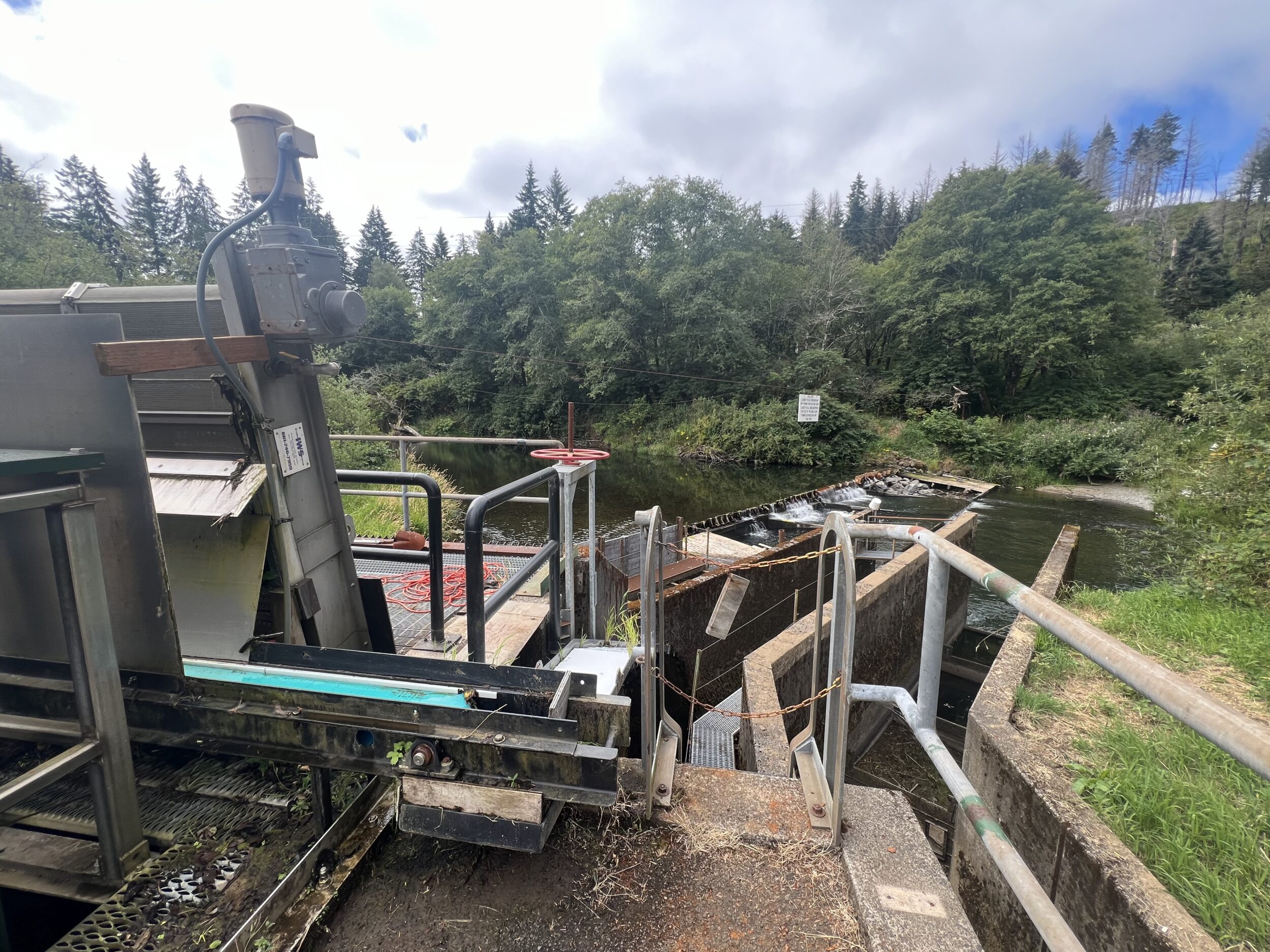
Hatchery review
The more immediate plans to close the facilities near Lincoln City, Waldport and Roseburg come at the same time the agency is leading a long review of all its hatchery operations that started when the Rock Creek Hatchery was destroyed but also with the realization that hatcheries consume a third of the fish division’s budget, that most were built in the 1950s and need repairs or modernization, and that climate change is greatly affecting operations.

“All these things coming together have put us at a tipping point,” ODFW deputy administrator Sean Clements told a webinar involving stakeholders and other interested parties last month.
But the agency also recognizes that 70 percent of the salmon and steelhead caught by commercial or recreational fishers each year originate in hatcheries. It has contracted with consultants to help understand the economics of hatcheries, look deeper into how warming temperatures and lower stream flows are affecting operations, and interviewing 10 interest groups to get their views.
It costs the agency $5 to raise each Rainbow trout that are planted in lakes and later caught by a fisherman. The cost of a salmon or steelhead? $200.
“We’re not expecting there will be consensus on this,” Clements said in August as he outlined areas of agreement ranging from climate change to fish abundance and disagreements on hatchery effectiveness and operations versus habitat restoration. “There was more common ground than challenges … not to sound PollyAnne-ish.”
Eventually, Clements said, ODFW will have to make hatchery investment decisions based on operating costs, deferred maintenance and adjusting to climate change.
“It’s a balance,” Harrington said. “You can’t just cut all hatcheries or all programs. So you sit down and make hard decisions. But we know which hatcheries are costing us the most.”
- Quinton Smith is the editor of YachatsNews.com and can be reached at YachatsNews@gmail.com



Saving Salmon and Steelhead fish from extinction is priceless! I think closure of any coastal hatchery because of not making changes and upgrades over the decades is a poor excuses for not dealing with the problem at hand. Now budget problems within ODFW. There are a lot of different areas ODFW can cut. Increasing already high cost Oregon fishing licenses and creating new ways to tax fishing licenses is not the way to go, especially with most recreational salmon fishing closures, fishing licenses should be reduced not increased. A Family of four can no longer afford go fishing together.
Our state has run off tax paying business by the hundreds even before COVID. Driving by towns with empty buildings which once housed small independent owners is so sad. Add them up mean loss of state tax revenue.
If the Salmon River Hatchery closes, I believe fishing should be closed above the new 101 bridge to somewhere above the hatchery starting Sept. 15. This would give the remaining salmon a chance. In low water years they stay in tidewater sometimes to the middle of October before the first big rain. It would also help to thin out the seal population that is a 1000% higher from when I first started fishing the river over 40 years ago. I am a Salmon River property owner and at this point, there are no native fish left that do not have some hatchery fish in them.
I am for the river closing as a land owner up river our native animals have starved our rivers dying when hatchery was closed from fire we had fish galore and love watching them spawn, also then with this new management that started about 8 years ago the salmon all get jacked by hatchery for fishermen below dam as up river has died . It will be wonderful to watch river come back to life when dams gone .
Five years and no more fishing, how sad.
Get rid of a lot of the engineers and get something done, raise more fish at the same cost.